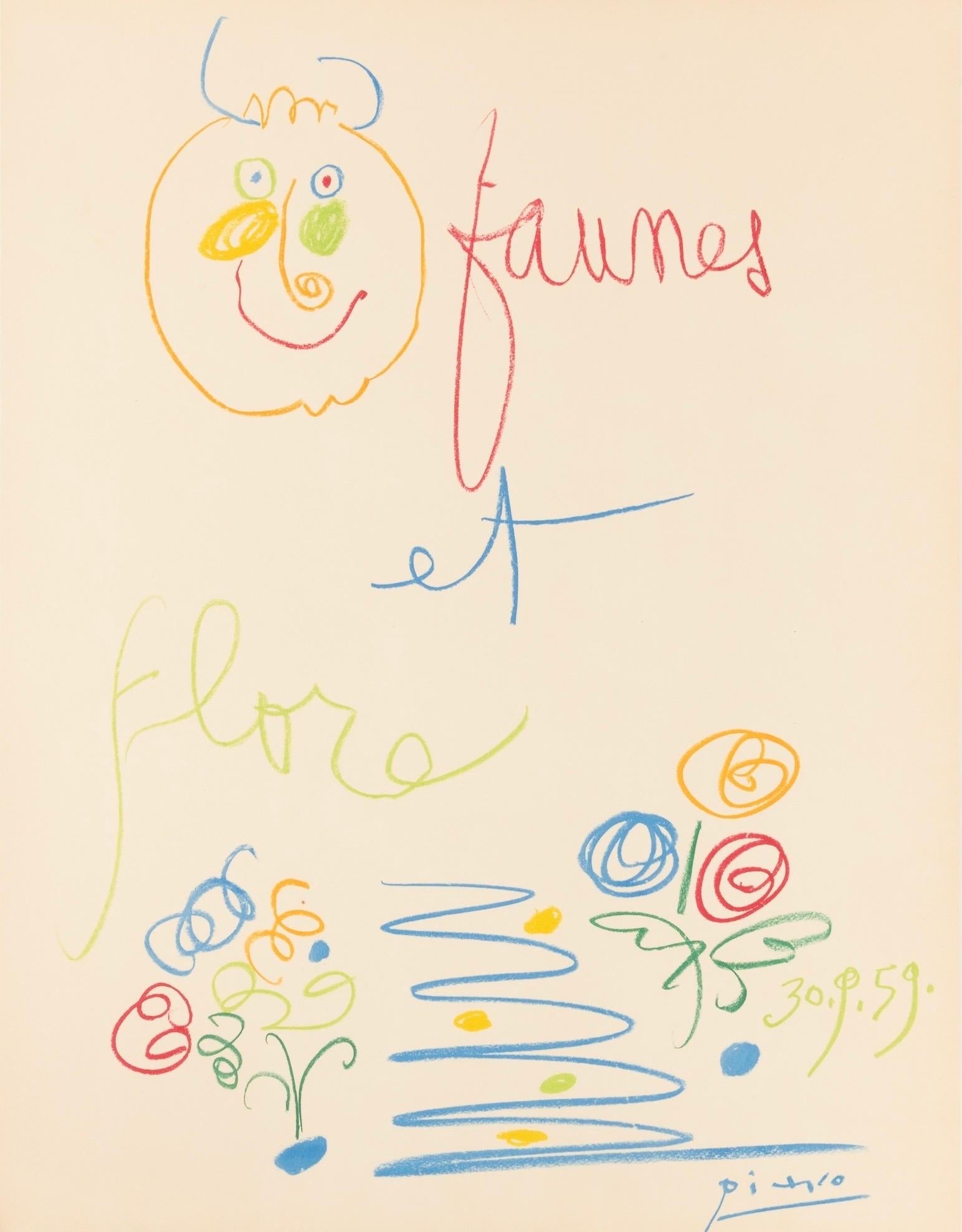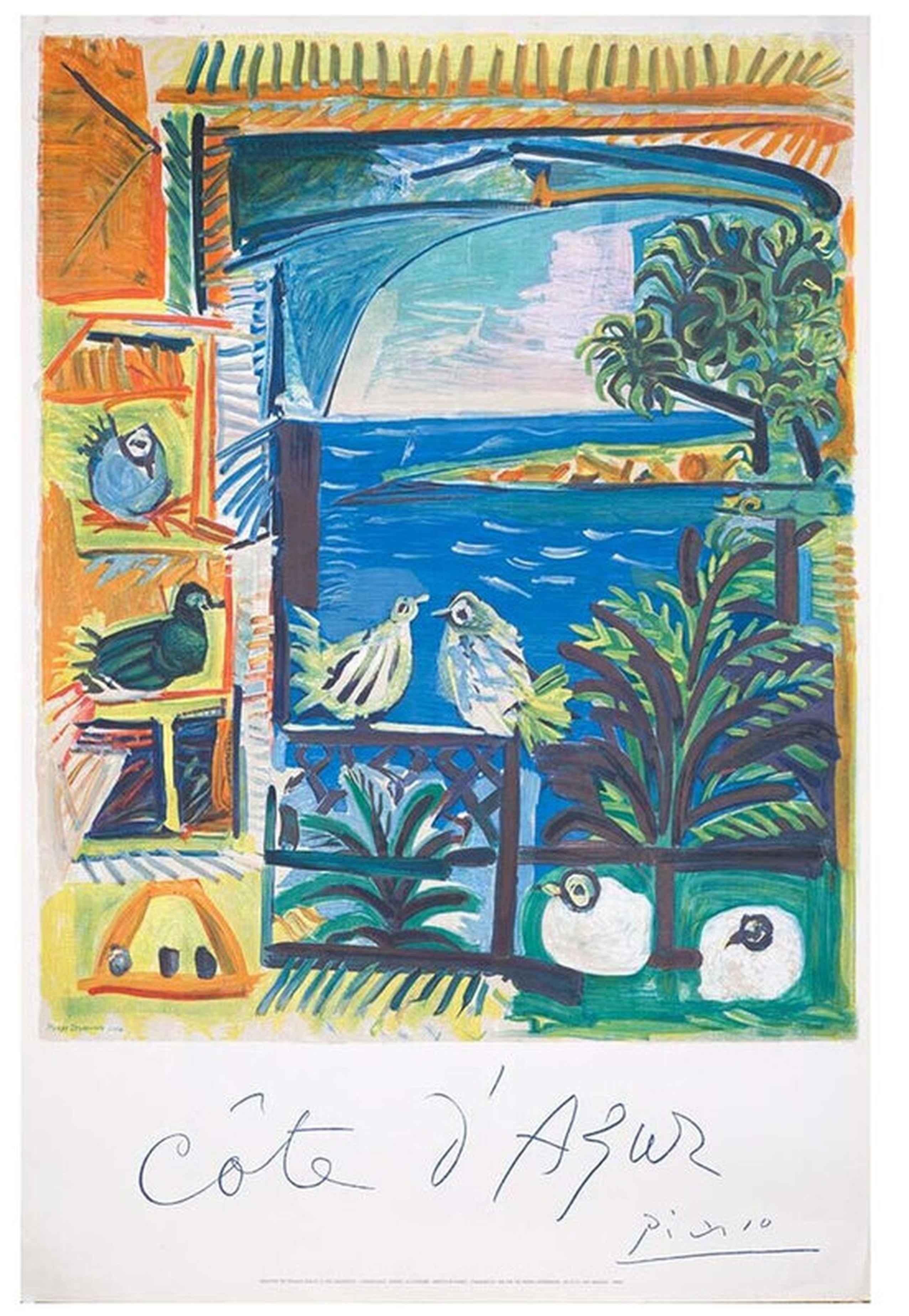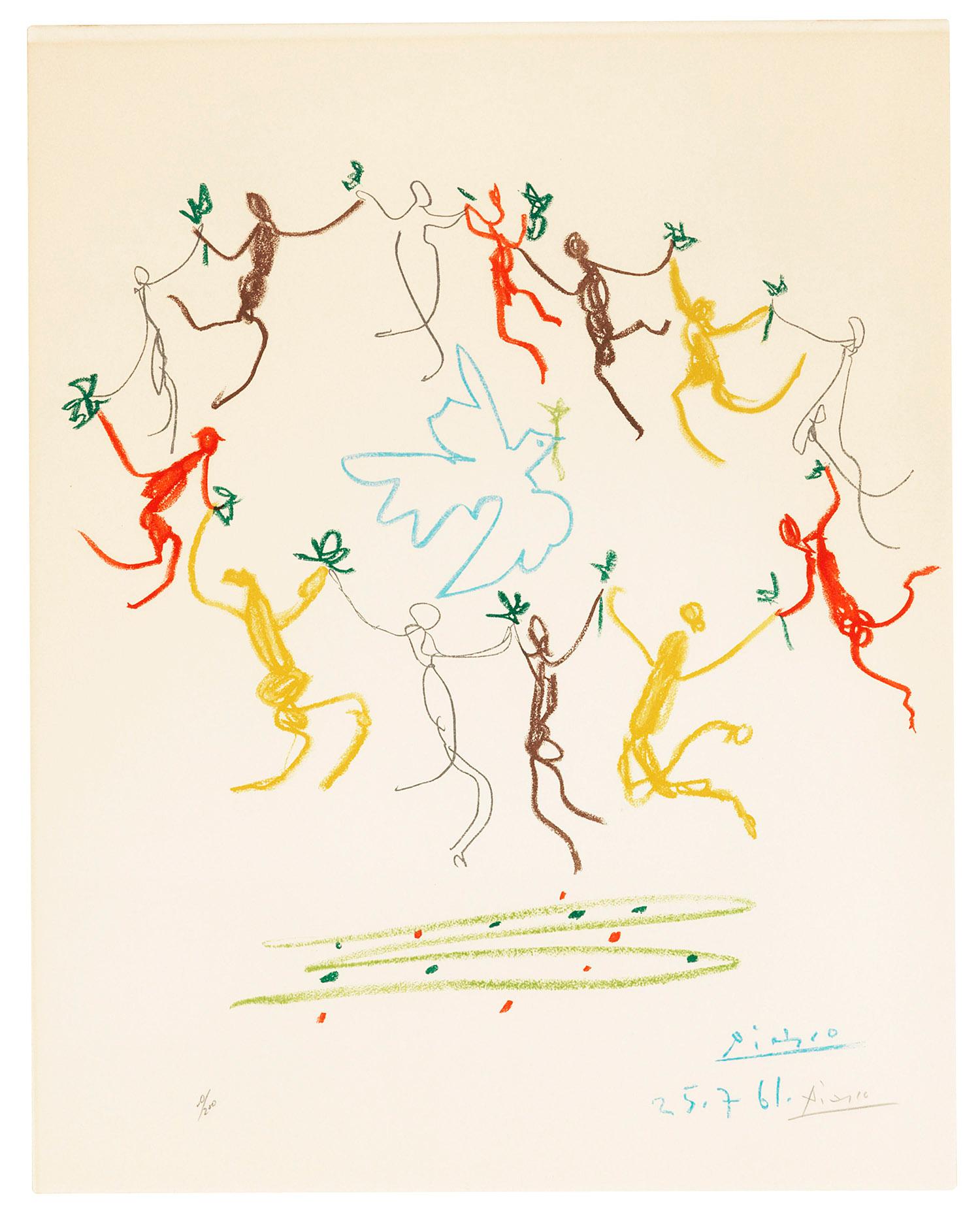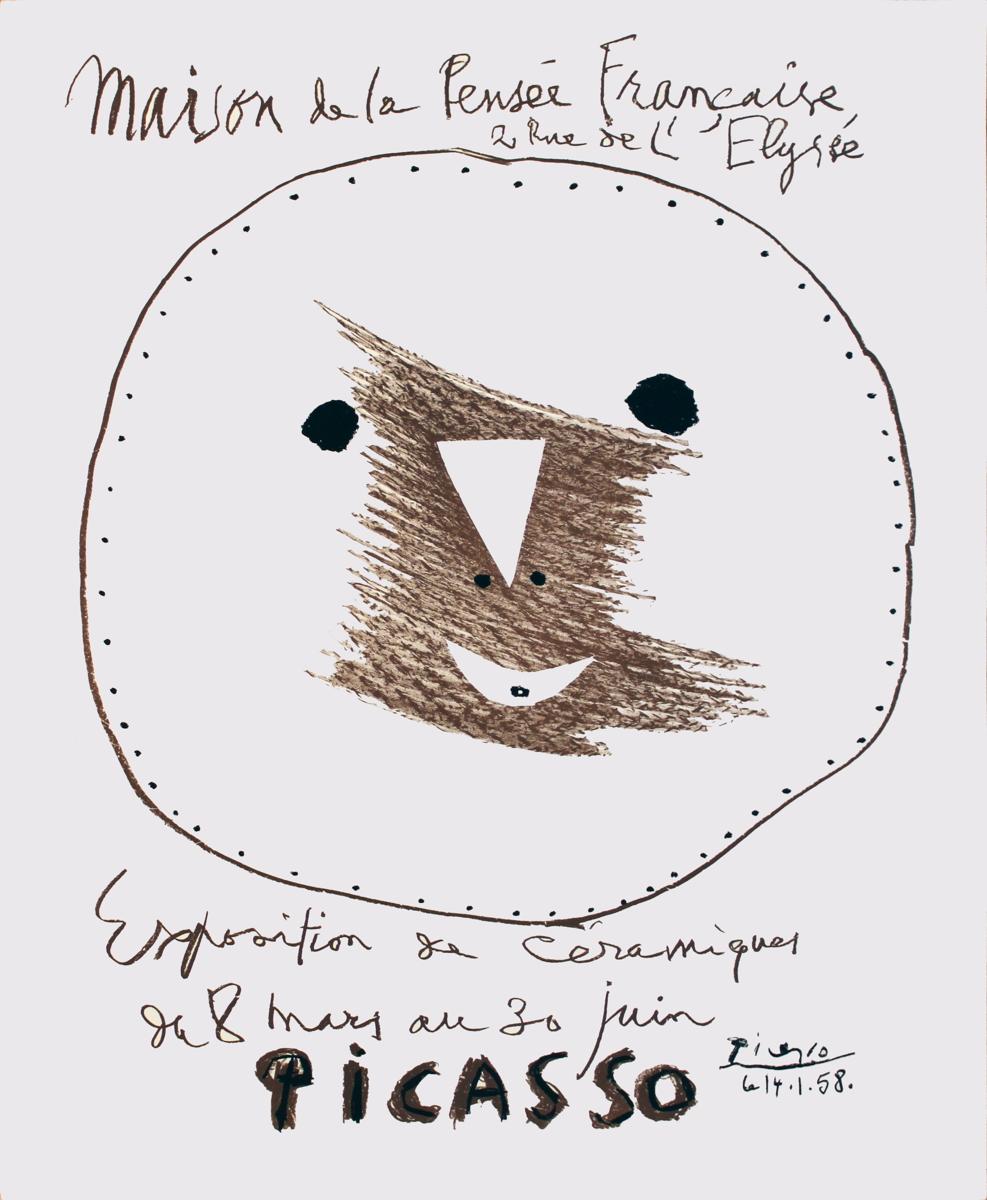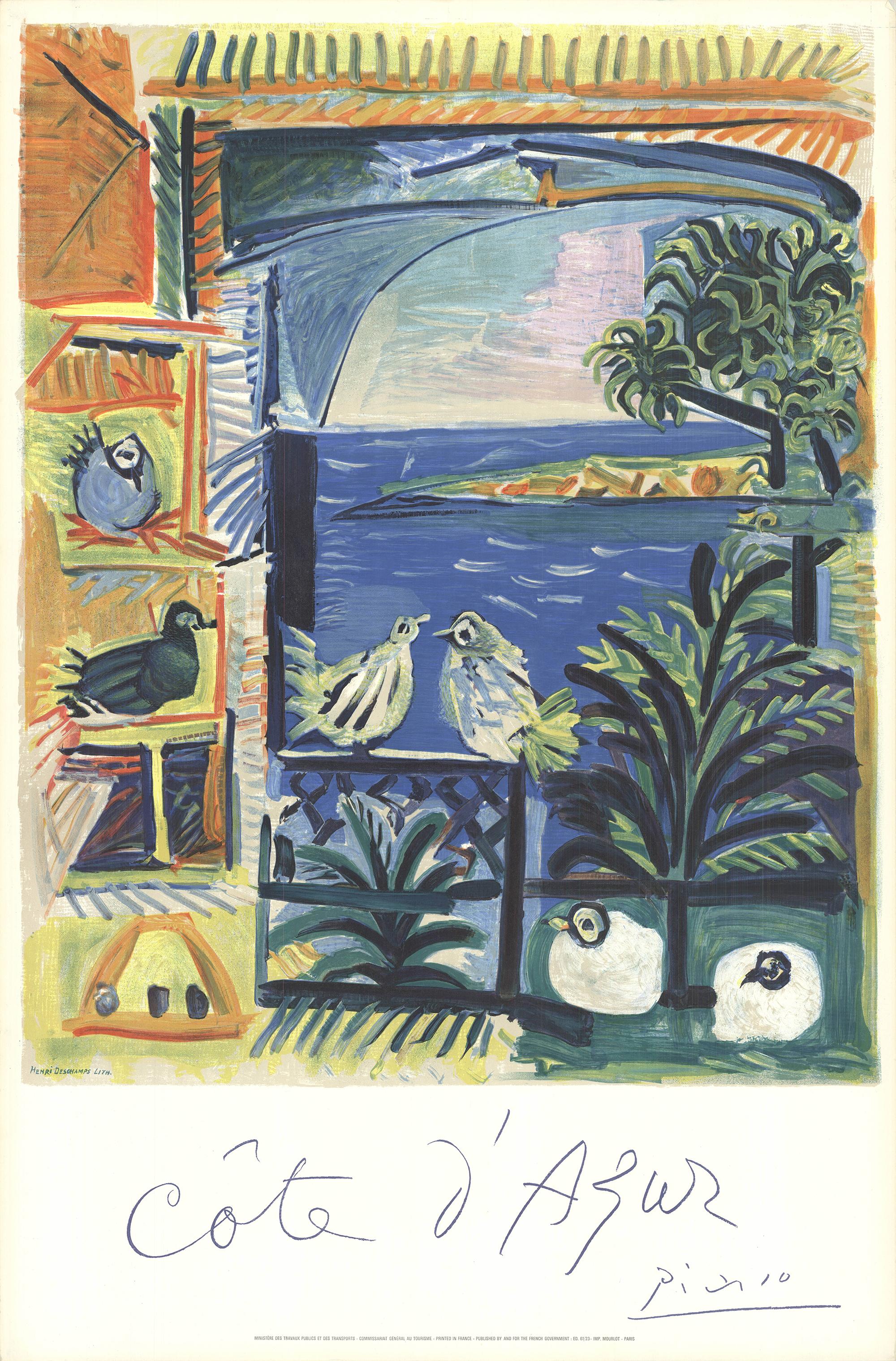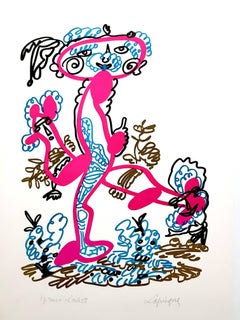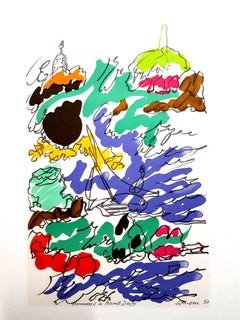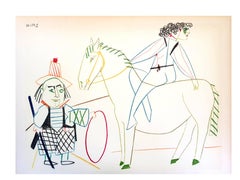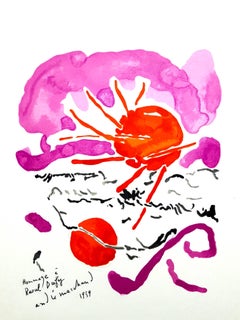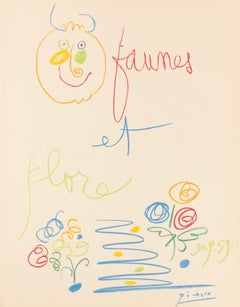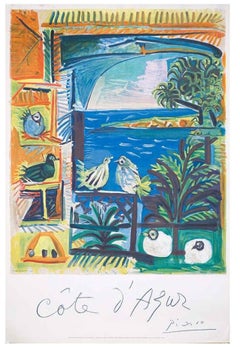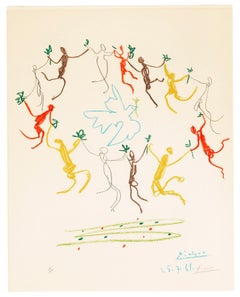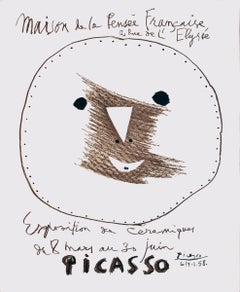Items Similar to After Pablo Picasso - Wildlife of Antibes - Lithograph
Want more images or videos?
Request additional images or videos from the seller
1 of 11
UnknownAfter Pablo Picasso - Wildlife of Antibes - Lithograph1959
1959
$2,830.15
£2,151.82
€2,400
CA$3,970.14
A$4,337.71
CHF 2,281.38
MX$52,150.21
NOK 28,724.48
SEK 26,968.49
DKK 18,279.66
About the Item
After Pablo PICASSO (1881-1973)
One plate from the book: Jaime Sabartés. "Faunes et flore d'Antibes" (Greenwich, Conn: New York Graphic Society, 1960).
Color Lithograph
63 x 47 cm
Picasso is not just a man and his work. Picasso is always a legend, indeed almost a myth. In the public view he has long since been the personification of genius in modern art. Picasso is an idol, one of those rare creatures who act as crucibles in which the diverse and often chaotic phenomena of culture are focused, who seem to body forth the artistic life of their age in one person. The same thing happens in politics, science, sport. And it happens in art.
Early life
Born in Malaga, Spain, in October of 1881, he was the first child born in the family. His father worked as an artist, and was also a professor at the school of fine arts; he also worked as a curator for the museum in Malaga. Pablo Picasso studied under his father for one year, then went to the Academy of Arts for one year, prior to moving to Paris. In 1901 he went to Paris, which he found as the ideal place to practice new styles, and experiment with a variety of art forms. It was during these initial visits, which he began his work in surrealism and cubism style, which he was the founder of, and created many distinct pieces which were influenced by these art forms.
Updates in style
During his stay in Paris, Pablo Picasso was constantly updating his style; he did work from the blue period, the rose period, African influenced style, to cubism, surrealism, and realism. Not only did he master these styles, he was a pioneer in each of these movements, and influenced the styles to follow throughout the 20th century, from the initial works he created. In addition to the styles he introduced to the art world, he also worked through the many different styles which appeared, while working in Paris. Not only did he continually improve his style, and the works he created, he is well known because of the fact that he had the ability to create in any style which was prominent during the time.
Russian ballet
In 1917, Pablo Picasso joined the Russian Ballet, which toured in Rome; during this time he met Olga Khoklova, who was a ballerina; the couple eventually wed in 1918, upon returning to Paris. The couple eventually separated in 1935; Olga came from nobility, and an upper class lifestyle, while Pablo Picasso led a bohemian lifestyle, which conflicted. Although the couple separated, they remained officially married, until Olga's death, in 1954. In addition to works he created of Olga, many of his later pieces also took a centralized focus on his two other love interests, Marie Theresa Walter and Dora Maar. Pablo Picasso remarried Jacqueline Roque in 1961; the couple remained married until his death 12 years later, in 1973.
Work as a pacifist
Pablo Picasso was a pacifist, and large scale paintings he created, showcased this cry for peace, and change during the time. A 1937 piece he created, after the German bombing of Guernica, was one such influential piece of the time. Not only did this become his most famous piece of art work, but the piece which showed the brutality of war, and death, also made him a prominent political figure of the time. To sell his work, and the message he believed in, art, politics, and eccentricity, were among his main selling points.
Conflicting with social views
Many things Pablo Picasso did during the 1950s, conflicted with the general public. Viciousness towards his children, exaggerated virility towards women, and joining the Communist party, were some of the many scandals which he was involved in during his lifetime. Although most of the things he did were viewed negatively by a minority of the general public, admirers of Pablo Picasso turned a blind eye, and still accepted him as a prominent figure in their society. Following the end of WWII, Pablo Picasso turned back towards his classic style of work, and he created the "Dove of Peace." Even though he became a member of the Communist party, and supported Stalin and his political views and rule, Pablo Picasso could do no wrong. In the eyes of his admirers and supporters, he was still a prominent figure, and one which they would follow, regardless of what wrongs he did. He was not only an influence because of the works he created, but he was also an influential figure in the political realm.
Influence outside of art
Although Pablo Picasso is mainly known for his influence to the art world, he was an extremely prominent figure during his time, and to the 20th century in general. He spread his influences to the art world, but also to many aspects of the cultural realm of life as well. He played several roles in film, where he always portrayed himself; he also followed a bohemian lifestyle, and seemed to take liberties as he chose, even during the later stages of his life. He even died in style, while hosting a dinner party in his home.
Collection of work
Pablo Picasso is recognized as the world's most prolific painter. His career spanned over a 78 year period, in which he created: 13,500 paintings, 100,000 prints and engravings, and 34,000 illustrations which were used in books. He also produced 300 sculptures and ceramic pieces during this expansive career. It is also estimated that over 350 pieces which he created during his career, have been stolen; this is a figure that is far higher than any other artist throughout history.
Sale of his works
Pablo Picasso has also sold more pieces, and his works have brought in higher profit margins, than any other artist of his time. His pieces rank among the most expensive art works to be created; with a price tag of $104 million, Garson a la Pipe, was sold in 2004.
Although he had a conflicting lifestyle, Pablo Picasso was admired by many, and was one of the most influential figures of his time. Not only during his life, but also after his death, he is still one of the most well known artists, and political figures, of his time. With thousands of pieces to his name, and art works which have been seen by millions, around the world, he has been a great influence to society, he has influenced the art world, and he introduced many new styles of art, which helped shape modern art, and modern styles artists follow today.
- Creation Year:1959
- Dimensions:Height: 24.81 in (63 cm)Width: 18.51 in (47 cm)Depth: 0.04 in (1 mm)
- Medium:
- Movement & Style:
- Period:
- Condition:
- Gallery Location:Collonge Bellerive, Geneve, CH
- Reference Number:1stDibs: LU16121730493
About the Seller
4.9
Gold Seller
Premium sellers maintaining a 4.3+ rating and 24-hour response times
Established in 2015
1stDibs seller since 2015
967 sales on 1stDibs
Typical response time: 1 hour
- ShippingRetrieving quote...Shipping from: Collonge Bellerive, Geneve, Switzerland
- Return Policy
Authenticity Guarantee
In the unlikely event there’s an issue with an item’s authenticity, contact us within 1 year for a full refund. DetailsMoney-Back Guarantee
If your item is not as described, is damaged in transit, or does not arrive, contact us within 7 days for a full refund. Details24-Hour Cancellation
You have a 24-hour grace period in which to reconsider your purchase, with no questions asked.Vetted Professional Sellers
Our world-class sellers must adhere to strict standards for service and quality, maintaining the integrity of our listings.Price-Match Guarantee
If you find that a seller listed the same item for a lower price elsewhere, we’ll match it.Trusted Global Delivery
Our best-in-class carrier network provides specialized shipping options worldwide, including custom delivery.More From This Seller
View AllCharles Lapicque (after) - Homage to Dufy - Lithograph
By Charles Lapicque
Located in Collonge Bellerive, Geneve, CH
Charles Lapicque
Original Handsigned Lithograph
Dimensions: 56 x 38 cm
Edition: Epreuve d'Artiste
Hand Signed
Charles Lapicque was one of the great painters of the “Ecole de Paris...
Category
1960s Modern Animal Prints
Materials
Lithograph
Charles Lapicque (after) - Homage to Dufy - Lithograph
By Charles Lapicque
Located in Collonge Bellerive, Geneve, CH
(after) Charles Lapicque
Lithograph after a watercolor, published in the book "Lettre à mon peintre Raoul Dufy." Paris, Librairie Académique Perrin, 1965.
Printed signatu...
Category
1940s Fauvist Animal Prints
Materials
Lithograph
The Human Comedy - Lithograph
By (after) Pablo Picasso
Located in Collonge Bellerive, Geneve, CH
After Pablo Picasso
The Human Comedy - Lithograph after an original drawing, as published in the journal "Verve"
Printed signature and date
Dimensions...
Category
1950s Modern Animal Prints
Materials
Lithograph
André Marchand (after) - Homage to Dufy - Lithograph
By André Marchand
Located in Collonge Bellerive, Geneve, CH
(after) André Marchand
Lithograph after a watercolor, published in the book "Lettre à mon peintre Raoul Dufy." Paris, Librairie Académique P...
Category
1940s Fauvist Animal Prints
Materials
Lithograph
The Human Comedy - Lithograph
By (after) Pablo Picasso
Located in Collonge Bellerive, Geneve, CH
after Pablo Picasso - The Human Comedy - Lithograph
Signed and dated in the plate
Dimensions: 32 x 24 cm
This artwork is a lithograph in colors on wov...
Category
1950s Modern Portrait Prints
Materials
Lithograph
Jean Cocteau - Surrealist Creature - Original Lithograph
By Jean Cocteau
Located in Collonge Bellerive, Geneve, CH
Original Lithograph by Jean Cocteau
Title: Surrealist Creature
Signed in the plate
Dimensions: 32 x 25.5 cm
Edition: 200
1959
Publisher: Bibliophiles Du Palais
Unnumbered as issued
Category
1950s Modern More Prints
Materials
Lithograph
You May Also Like
Pablo Picasso, Fauns and Flora of Antibes, Frontispiece, 1960 (after)
By Pablo Picasso
Located in Southampton, NY
This exquisite lithograph and pochoir after Pablo Picasso (1881–1973), titled Faunes et Flore d'Antibes (Fauns and Flora of Antibes), Frontispice, from the folio, Picasso, Faunes et ...
Category
1960s Cubist Figurative Prints
Materials
Stencil, Lithograph
$7,996 Sale Price
20% Off
Free Shipping
Cote D'Azur 1962 stone lithograph (after)Pablo Picasso
By Pablo Picasso
Located in Dubai, Dubai
Cote D'Azur 1962 stone lithograph
After Pablo Picasso
Pablo Picasso was a Spanish painter, sculptor, and co-founder of the Cubist movement, which revolutionized European painting ...
Category
1960s Contemporary Interior Prints
Materials
Lithograph
Pablo Picasso (After), 'La Ronde de la Jeunesse', Lithograph, 1961
By Pablo Picasso
Located in Pembroke Pines, FL
Artist: PABLO PICASSO (AFTER )
Title: 'La Ronde de la Jeunesse (The Youth Circle)'
Year: 1961
Published by: Combat Pour La Paix, Paris
Medium: Lithograph on wove paper
Printed by Mourlot
Edition: 200 plus EA
Size: 26 x 20 inches
Signed and numbered in pencil by the master
CERTIFICATE OF AUTHENTICITY INCLUDED
ARTWORK IS IN EXCELLENT CONDITION
Through the use of crisp vibrant colors and the fluid use of line, Picasso creates a sense of optimistic energy that is focused around the dove of peace in Pablo Picasso La Ronde de la Jeunesse...
Category
1950s Contemporary Animal Prints
Materials
Lithograph
Picasso-Maison de la Pensee Francaise- ORIGINAL LITHOGRAPH- Vintage
By Pablo Picasso
Located in Brooklyn, NY
Maison de la Pensée Française is a 1958 lithograph by Pablo Picasso, produced by Mourlot in Paris. It is referenced in several key catalogues documenting Picasso’s lithographic work:...
Category
20th Century Cubist Prints and Multiples
Materials
Lithograph
$720 Sale Price
20% Off
Picasso Cote D'Azur Poster- Original Lithograph- 1962 VINTAGE
By Pablo Picasso
Located in Brooklyn, NY
Côte d'Azur is a lithograph designed by Pablo Picasso in collaboration with Henri Deschamps, depicting a view from Picasso's balcony overlooking the Côte d'Azur. Created in 1962, thi...
Category
1960s Cubist Still-life Prints
Materials
Lithograph
$2,000 Sale Price
20% Off
Suite de Dessins Cover Illustration - Lithograph
By (after) Pablo Picasso
Located in Paris, IDF
(after) Pablo PICASSO
Suite de 180 Dessins
Lithograph, 1954
Printed signature in the plate
Size 38 x 26.5 cm (c. 15 x 10,45 inch)
Lithograph created for...
Category
1950s Modern Figurative Prints
Materials
Lithograph
More Ways To Browse
Vintage Book Plates
Keith Haring Pyramid
Keith Haring Retrospect
Kim Jong Un
Kim Tschang Yeul
Klimt Embrace
L Jambor
Last Supper Lithograph
Le Joueur De Flute
Lech Poster
Leonda Finke
Leonor Fini Sphinx
Leroy Neiman Artist Proof
Leroy Neiman Cafe
Leroy Neiman Football
Leroy Neiman Frank Sinatra Prints
Leroy Neiman Frank Sinatra
Leroy Neiman Sailing
